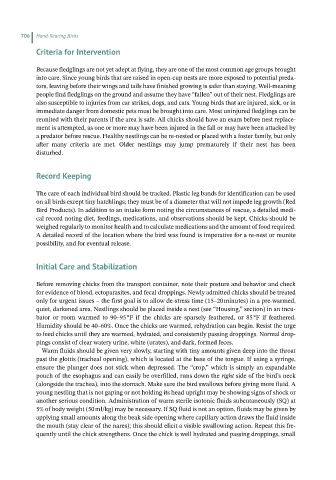Page 704 - Hand rearing birds second
P. 704
706 Hand-Rearing Birds
Criteria for Intervention
Because fledglings are not yet adept at flying, they are one of the most common age groups brought
into care. Since young birds that are raised in open‐cup nests are more exposed to potential preda-
tors, leaving before their wings and tails have finished growing is safer than staying. Well‐meaning
people find fledglings on the ground and assume they have “fallen” out of their nest. Fledglings are
also susceptible to injuries from car strikes, dogs, and cats. Young birds that are injured, sick, or in
immediate danger from domestic pets must be brought into care. Most uninjured fledglings can be
reunited with their parents if the area is safe. All chicks should have an exam before nest replace-
ment is attempted, as one or more may have been injured in the fall or may have been attacked by
a predator before rescue. Healthy nestlings can be re‐nested or placed with a foster family, but only
after many criteria are met. Older nestlings may jump prematurely if their nest has been
disturbed.
Record Keeping
The care of each individual bird should be tracked. Plastic leg bands for identification can be used
on all birds except tiny hatchlings; they must be of a diameter that will not impede leg growth (Red
Bird Products). In addition to an intake form noting the circumstances of rescue, a detailed medi-
cal record noting diet, feedings, medications, and observations should be kept. Chicks should be
weighed regularly to monitor health and to calculate medications and the amount of food required.
A detailed record of the location where the bird was found is imperative for a re‐nest or reunite
possibility, and for eventual release.
Initial Care and Stabilization
Before removing chicks from the transport container, note their posture and behavior and check
for evidence of blood, ectoparasites, and fecal droppings. Newly admitted chicks should be treated
only for urgent issues – the first goal is to allow de‐stress time (15–20 minutes) in a pre‐warmed,
quiet, darkened area. Nestlings should be placed inside a nest (see “Housing,” section) in an incu-
bator or room warmed to 90–95 °F if the chicks are sparsely feathered, or 85 °F if feathered.
Humidity should be 40–60%. Once the chicks are warmed, rehydration can begin. Resist the urge
to feed chicks until they are warmed, hydrated, and consistently passing droppings. Normal drop-
pings consist of clear watery urine, white (urates), and dark, formed feces.
Warm fluids should be given very slowly, starting with tiny amounts given deep into the throat
past the glottis (tracheal opening), which is located at the base of the tongue. If using a syringe,
ensure the plunger does not stick when depressed. The “crop,” which is simply an expandable
pouch of the esophagus and can easily be overfilled, runs down the right side of the bird’s neck
(alongside the trachea), into the stomach. Make sure the bird swallows before giving more fluid. A
young nestling that is not gaping or not holding its head upright may be showing signs of shock or
another serious condition. Administration of warm sterile isotonic fluids subcutaneously (SQ) at
5% of body weight (50 ml/kg) may be necessary. If SQ fluid is not an option, fluids may be given by
applying small amounts along the beak side opening where capillary action draws the fluid inside
the mouth (stay clear of the nares); this should elicit a visible swallowing action. Repeat this fre-
quently until the chick strengthens. Once the chick is well hydrated and passing droppings, small

